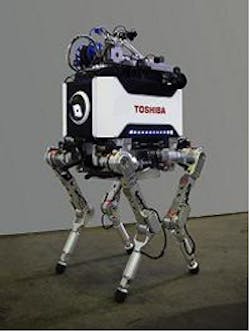Vision guided robot enters risky areas
Engineers at Toshiba Corporation (Tokyo, Japan) have developed a tetrapod robot that is able to carry out investigative and recovery work in locations that are too risky for people to enter, such as Tokyo Electric Power Plant Fukushima No.1 nuclear power plant.
The new robot integrates a camera and dosimeter and can investigate the condition of nuclear power plants under remote-control.
The multiple joints of its legs are controlled by a dedicated algorithm that enables the robot to walk on uneven surfaces, avoid obstacles and climb stairs, securing access into areas that present a challenge to wheeled robots or crawlers.
The robot also has a folding arm that can release a companion smaller robot with a second camera. Connected to the main robot by a cable, it can be positioned to take images of narrow places too small for the larger robot to enter.
Toshiba engineers plan to continue to enhance the capabilities of the robot to enable it to position and install shielding, stop flows of water and remove obstacles.
Related articles on robotic inspection from Vision Systems Design.
1. Vision robot inspects accelerator cavities
Engineers at Deutsches Elektronen-Synchrotron (DESY; Hamburg, Germany) have developed a fully automated robot to inspect the surface structures of superconducting accelerator cavities.
2. MIT robot navigates using Microsoft's Kinect
Researchers at the at MIT’s Computer Science and Artificial Intelligence Laboratory (CSAIL; Cambridge, MA, USA) have developed a robot that uses Microsoft’s Kinect to navigate through its surroundings.
3. Marine robot captures images of wrecks
A marine robot designed and built by University of Limerick (UL; Limerick, Ireland) researchers was recently deployed to explore wrecks of The Aud and WW1 U-Boat, UC42 outside Cork Harbor.
4. UK researchers to give legs to robot vision
Researchers at Bristol University (Bristol, UK) led by Dr. Jeremy Burn are involved in a £500,000 project sponsored by the Engineering and Physical Sciences Research Council (EPSRC) that will see them create a vision-based control system for legged robotic systems that can travel over complex terrains.
5. Robotic system identifies landmines
Researchers at the Department of Computer and Communications Engineering at the American University of Science and Technology (Beirut, Lebanon) have developed a vision system for a landmine detecting robot.
Vision Systems Design magazine and e-newsletter subscriptions are free to qualified professionals. To subscribe, please complete the form here.
-- Dave Wilson, Senior Editor, Vision Systems Design
